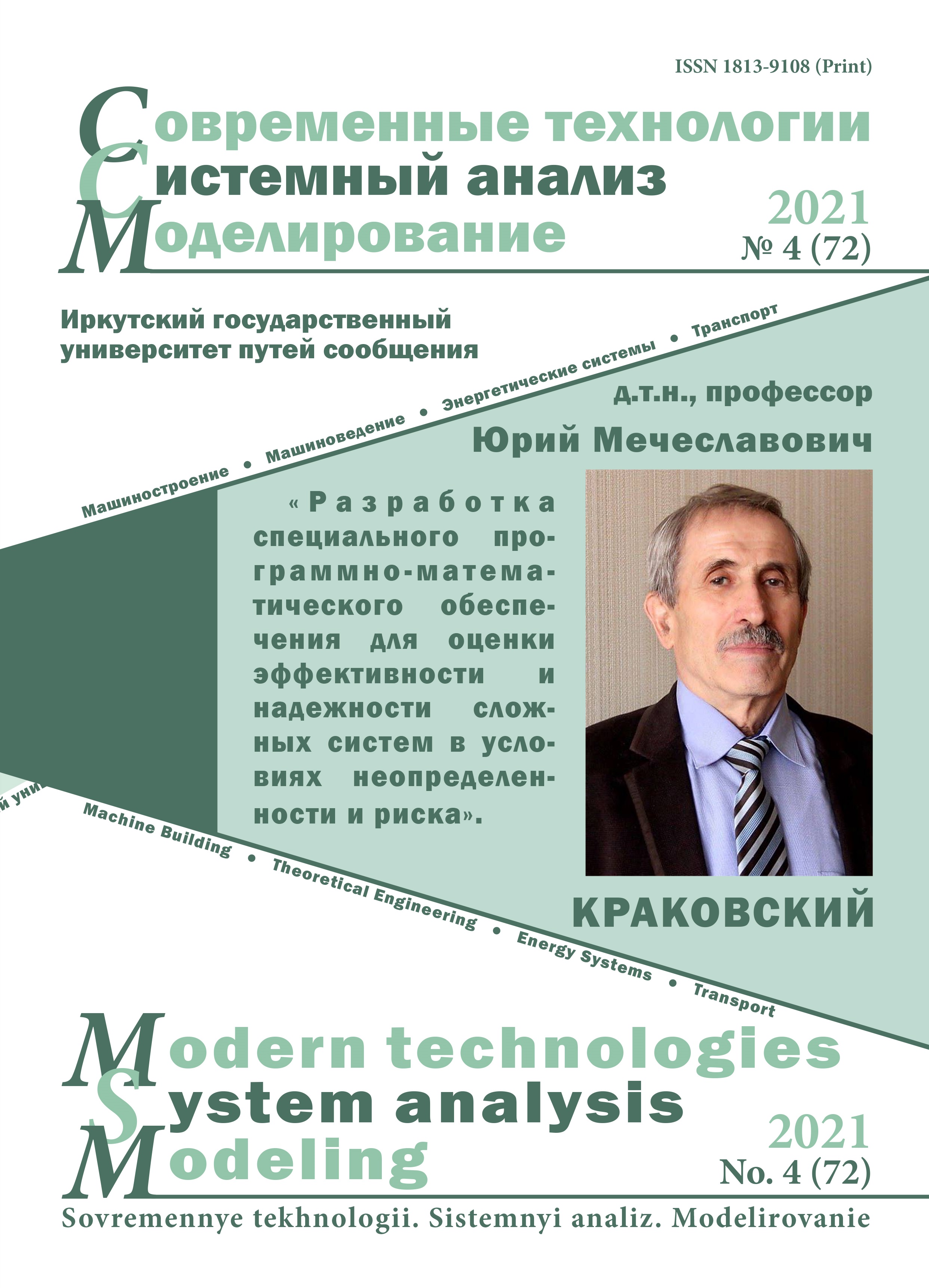Extreme control system of auxiliary drive of electric locomotives
Keywords:
asynchronous motor, simulation, vector control, rotating coordinate system, extreme control, MatLab / SimulinkAbstract
One of the ways to increase the energy efficiency of an induction motor is the use of an extreme control system. The increase in energy efficiency is achieved by reducing the power consumed by the motor to extremely low values by changing the value of the rotor flux linkage. The purpose of the work is to increase the energy efficiency of the vector control system of an induction motor by optimizing the setting of the rotor flux linkage. The flux linkage optimum value is determined in accordance with the criterion of the minimum consumed stator current depending on the set value of the electromagnetic torque on the motor shaft. The disadvantage of classical systems of extreme regulation is low performance due to the large value of the search time for the extremum point. Thus, classical search engines are applicable in established operating modes. In the event of a deviation in the parameters of the engine or a change in its operating mode, it is necessary to carry out a new search for an extremum with each change, which is impossible due to low speed of performance. In this regard, the use of classical extremal controllers is limited. To eliminate this drawback, it is proposed to use an extreme control system with a variable step during the operation of the regulator. Herewith, the control system provides an increase in the energy performance of the asynchronous motor both in the nominal and non-nominal operating modes. It is advisable to use the proposed regulation algorithm in the drive of auxiliary machines of an electric locomotive. A typical asynchronous motor with a squirrel-cage rotor of the 4A225 M4 U2 type, installed in the VL85 motor-fan drive, was used in the work. The proposed extreme control system allows to reduce power losses in the engine in all modes of its operation. For the motor 4A225 M4 U2 considered in the work, the stator current was reduced by 15 %, and the search time by 40% in comparison with the classical method of extreme regulation with a constant search step.
References
Yousef A. Abdel maksoud S. Review on Field Oriented Control of Induction Motor. International Journal For Research In Emerging Science And Tech-nology. 2015. Vol. 2. No. 7. 12 p.
Mekrini Z., Bri S. A Modular Approach and Simulation of an Asynchronous Machine. International Journal of Electrical and Computer Engineering. 2016. Vol. 4. No 6. 10 p.
Вольдек А.И. Электрические машины. М.: Энергия, 1974. 839 с.
Калачёв Ю.Н. SimInTech: моделирование в электроприводе. М. ДМК Пресс. 2019. 98 с.
Kulinich Yu.M., Shukharev S.A. Application of an Extreme Control Sys-tem to Operate the Reactive Power Compensator of an Electric Locomotive. Russian Electrical Engineering. 2016. Vol. 2. No. 87. 3 p.
Растригин Л.А. Системы экстремального управления. М.: Наука, 1974. 623 с.
Кулинич Ю.М., Шухарев С.А., Гуляев А.В. Устройство экстремального управления асинхронного двигателя. Заявка на изобретение № 2021121608 Российская Федерация, МПК B 60 L 3/10.: заявл. 20.07.2021.
Кравчик А.Э., Шлаф М.М. Асинхронные двигатели серии 4А. М.: Энергоиздат, 1982. 504 с.
Кулинич Ю.М., Шухарев С.А. Повышение энергетических показателей электровоза переменного тока за счет новой структуры управления компенсатором. Электротехника. 2016. № 9. С. 57–61.
Kulinich Y.M., Shukharev S.A. Improving the energy performance of an ac electric locomotive using a new compensator control structure. Russian Electrical Engineering. 2016. Vol. 87. No. 9. P. 532–535. DOI 10.3103/S106837121609008X.
Шухарев С.А. Повышение энергетической эффективности электровозов переменного тока на основе применения экстремального компенсатора реактивной мощности: автореф. дисс. на соиск. уч. ст. кан. техн. наук. Комсомольск-на-Амуре, 2017. 24 c.
Березин И.С., Жидков Н.П. Методы вычислений. Т. 1. М.: ГИФМЛ, 1962. 464 с.
Дьяконов В.П. Simulink: Самоучитель. М.: ДМК Пресс, 2015. 782 с.
Герман-Галкин С.Г. Виртуальные лаборатории полупроводниковых систем в среде Matlab-Simulink. СПб.: Лань, 2013. 448 с.
Терехин В.Б. Моделирование систем электропривода в Simulink (MatLab 7.0.1). Томск: Изд-во ТПУ, 2008. 320 с.
Eshkabilov S. Beginning MATLAB and Simulink: From Novice to Professional. Apress, 2019. 544 p.
Усольцев А.А. Частотное управление асинхронным двигателем. СПб.: изд-во СПбГУ ИТМО, 2006. 94 с.
Панкратов В.В. Векторное управление асинхронными электроприводами. Новосибирск: изд-во НГТУ, 1999. 66 с.


